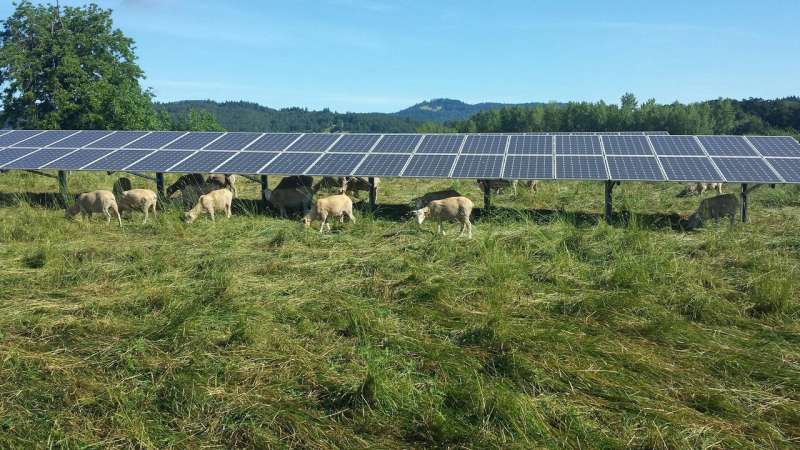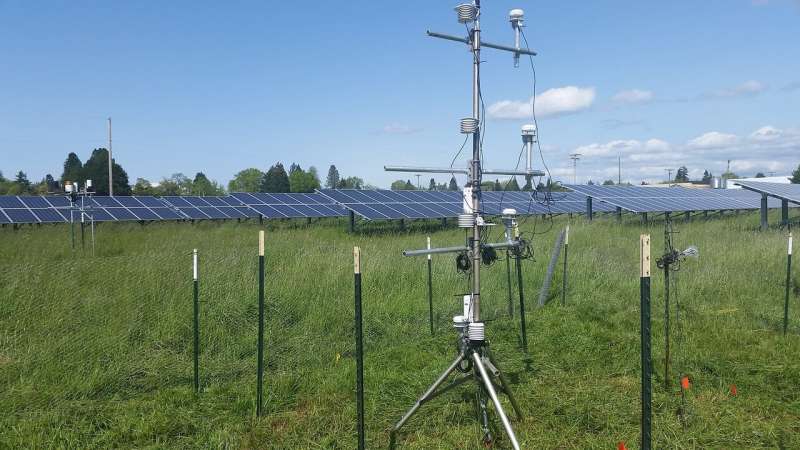Installing solar panels on agricultural lands maximizes their efficiency, new study shows

The most productive places on Earth for solar power are farmlands, according to an Oregon State University study.
The study, published today in the journal Scientific Reports, finds that if less than 1 percent of agricultural land was converted to solar panels, it would be sufficient to fulfill global electric energy demand. The concept of co-developing the same area of land for both solar photovoltaic power and conventional agriculture is known as agrivoltaics.
"Our results indicate that there's a huge potential for solar and agriculture to work together to provide reliable energy," said corresponding author Chad Higgins, an associate professor in OSU's College of Agricultural Sciences. "There's an old adage that agriculture can overproduce anything. That's what we found in electricity, too. It turns out that 8,000 years ago, farmers found the best places to harvest solar energy on Earth."
The results have implications for the current practice of constructing large solar arrays in deserts, Higgins said.
"Solar panels are finicky," he said. "Their efficiency drops the hotter the panels get. That barren land is hotter. Their productivity is less than what it could be per acre."
For their study, OSU researchers analyzed power production data collected by Tesla, which has installed five large grid-tied, ground-mounted solar electric arrays on agricultural lands owned by Oregon State. Specifically, the team looked at data collected every 15 minutes at the 35th Street Solar Array installed in 2013 on the west side of OSU's Corvallis campus.
The researchers synchronized the Tesla information with data collected by microclimate research stations they installed at the array that recorded mean air temperature, relative humidity, wind speed, wind direction, soil moisture and incoming solar energy.

Based on those results, Elnaz Hassanpour Adeh, a recent Ph.D. graduate from OSU's water resources engineering program and co-author on the study, developed a model for photovoltaic efficiency as a function of air temperature, wind speed and relative humidity.
"We found that when it's cool outside the efficiency gets better," Higgins said. "If it's hot the efficiency gets worse. When it is dead calm the efficiency is worse, but some wind makes it better. As the conditions became more humid, the panels did worse. Solar panels are just like people and the weather, they are happier when it's cool and breezy and dry."
Using global maps made from satellite images, Adeh then applied that model worldwide, spanning 17 classes of globally accepted land cover, including classes such as croplands, mixed forests, urban and savanna. The classes were then ranked from best (croplands) to worst (snow/ice) in terms of where a solar panel would be most productive.
The model was then re-evaluated to assess the agrivoltaic potential to meet projected global electric energy demand that has been determined by the World Bank.
Higgins and Adeh previously published research that shows that solar panels increase agricultural production on dry, unirrigated farmland. Those results indicated that locating solar panels on pasture or agricultural fields could increase crop yields.
More information: Elnaz H. Adeh et al. Solar PV Power Potential is Greatest Over Croplands, Scientific Reports (2019). DOI: 10.1038/s41598-019-47803-3
















